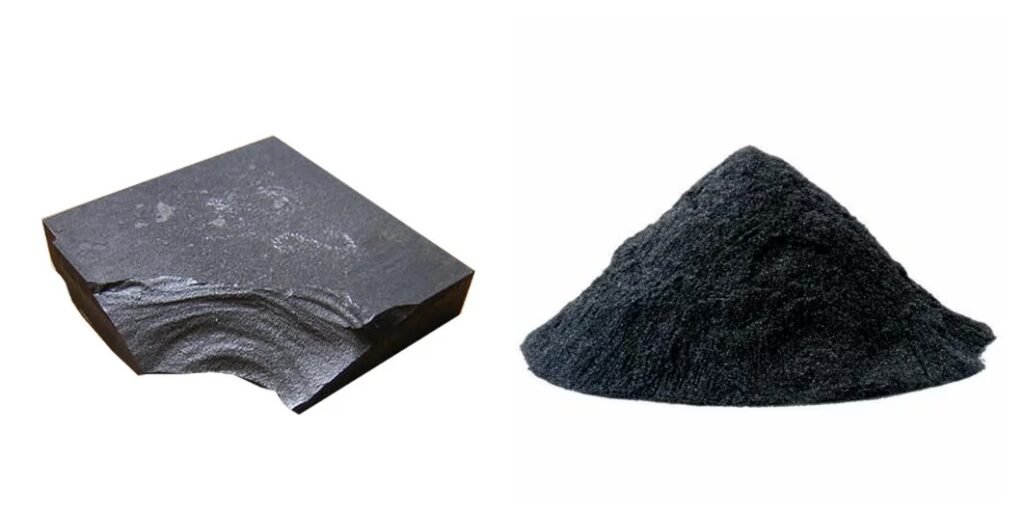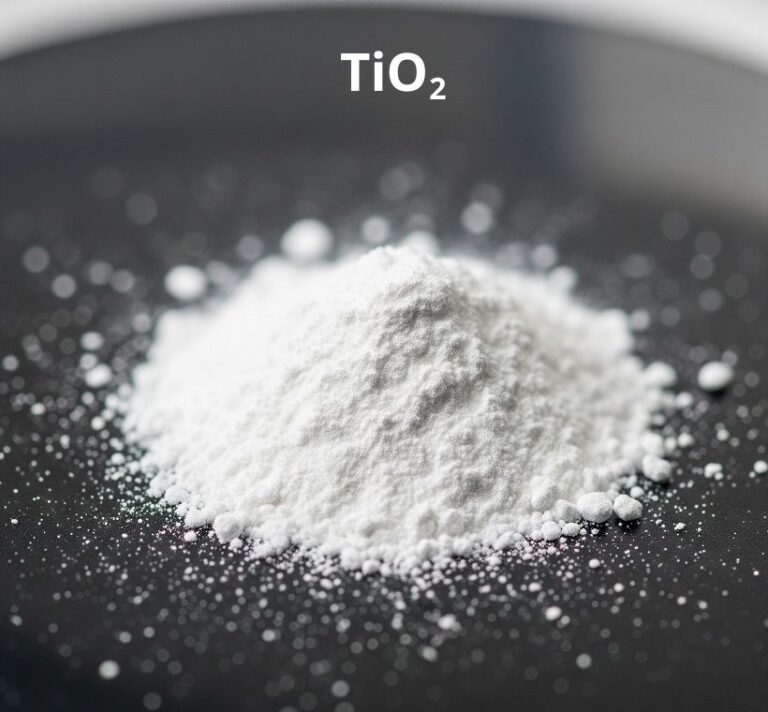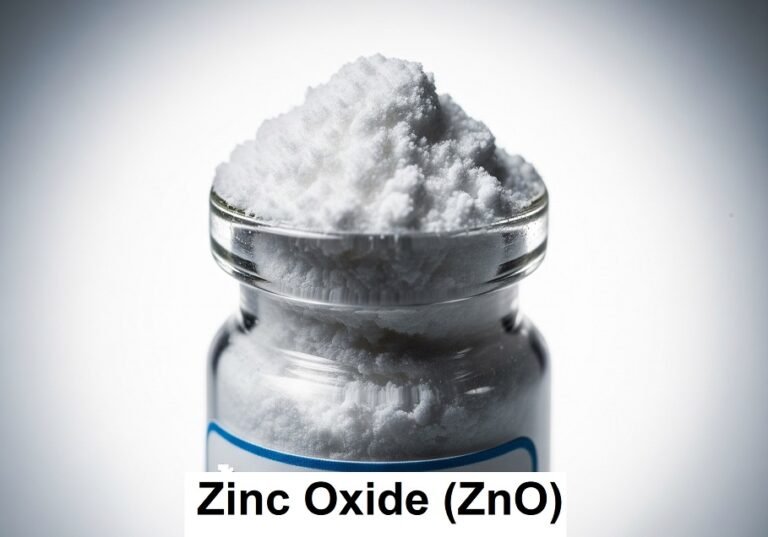
Boron carbide is a member of the important nonmetallic hard materials group alongside alumina, silicon carbide, and diamond with the chemical formula B4C. It is a black ceramic covalent material.
Boron carbide was first synthesized over a century ago in 1883 by Joly. Despite this early discovery, the formula B4C was not definitively established until 1934.
Today, a homogeneity range spanning from B4.3C to B10.4C has been recognized. Commercial boron carbide typically exhibits a boron-to-carbon stoichiometry close to 4:1, representing the stoichiometric limit on the high-carbon side.
Boron carbide stands out as an exceptionally hard material, surpassed only by diamond and cubic boron nitride. It has a high melting point, exceptional mechanical strength coupled with low density, a significant neutron absorption capability, and semiconducting properties.
Table of Contents
1. Physical Properties of Boron Carbide
The purest B4C crystals obtained through electrothermal production exhibit a deep black and shiny appearance, distinct from the transparent and colorless nature of SiC crystals in their purest form. These crystals melt congruently at 2450 °C and boil above 3500 °C. B4C with the natural isotopic composition possesses a density of 2.52 g/cm³, while 10B4C is less dense at 2.37 g/cm³.
With a Knoop microhardness number HK-0.1 of approximately 3000, measured under a load of 0.1 kp (equivalent to 0.98 N), Boron Carbide surpasses all but diamond in terms of hardness. For comparison, the HK-0.1 values for α-Al2O3, SiC, elemental boron, and cubic BN are 2000, 2600, 4700, and 7000-8000, respectively. This remarkable hardness suggests that all the hardest known materials, except diamond, contain boron.
Table 1 summarizes the mechanical properties of hot-pressed B4C and B4C-based composites manufactured by ESK. These materials exhibit a nearly 100% transgranular fracture mode. Boron Carbide retains its hardness and strength up to 1500°C in an inert atmosphere, classifying it as a refractory material.
| Property | HP B4Ca | B4C (5 % C)b | BT 60/40c |
|---|---|---|---|
| Bulk density, g/cm3 | 2.51 | 2.51 | 3.30 |
| Flexural strength (4-point, 20 °C), MPa | 480 | 560 | 730 |
| Knoop hardness | 2910 | 2860 | 2900 |
| Fracture toughness KIc, MPa √m1/2 | 2.2 | 2.1 | 6.5 |
| Young's modulus, GPa | 441 | 450 | 480 |
| Mean grain size, mm | 5 | 2 | 5 |
b HIP treated sintered B4C with 4 wt % free carbon.
c HIP treated sintered B4C – TiB2 composite with 40 vol % TiB2.
The average coefficient of thermal expansion for B4C over the range 25-800 °C is 4.6 x 10-6 K-1, closely matching that of pure SiC ceramic. The coefficient of thermal expansion as a function of temperature (t in °C) can be expressed as:
a = 3.016 x 10-6 + 4.30 x 10-9 t2 + 9.18 x 10-13 t3
Thermal conductivity decreases with increasing temperature:
| Temperature (°C) | Thermal Conductivity (W m-1 K-1) |
|---|---|
| 25 | 35 |
| 200 | 28 |
| 400 | 23 |
| 600 | 19 |
| 800 | 16 |
Despite its high thermal conductivity, boron carbide exhibits low resistance to thermal shock.
Boron carbide acts as a high-temperature p-type semiconductor with a forbidden bandgap of 0.8 eV. Its electrical conductivity depends on the B:C ratio and impurity content.
The specific electrical resistance of boron carbide ranges from 0.1 to 10 Ω.cm, comparable to that of SiC and graphite. Similar to other ceramic materials, boron carbide displays a negative temperature coefficient of resistivity.
It also possesses a high thermoelectric power, which increases with temperature.
Boron carbide’s nuclear properties make it an effective neutron absorber in most reactor types. The effectiveness of boron as a neutron absorber stems from the large cross-section of the 10B isotope (approximately 4000 barns). The natural abundance of 10B is 19.9 ± 0.3 mol%.
The (n, α) reaction:( 10B + 1n → 4He + 7Li + 2.97 MeV ) produces helium and lithium without releasing any radioactive nuclei. Unlike cadmium or the lanthanides, boron does not produce radioisotopes. Additionally, the secondary gamma radiation is negligible.
The cross-section exhibits a linear relationship with neutron energy and follows a 1/v dependence. The cross-sections of boron over the entire neutron energy spectrum (0.01-1000 eV) are sufficiently large to render boron effective in thermal, intermediate, and fast reactors.
2. Chemical Properties of Boron Carbide
Boron carbide stands out as an exceptionally stable compound, exhibiting resistance to dissolution in mineral acids or aqueous alkali. However, it can be decomposed gradually by mixed hydrofluoric-sulfuric acid or hydrofluoric-nitric acid.
A refining technique for boron carbide separation from free carbon and boron exploits the distinct oxidation rates of these elements and boron carbide. The boron carbide powder is heated in a mixture of H2SO4, HNO3, HClO4, and K2Cr2O7.
Molten alkali induces the decomposition of boron carbide, leading to the formation of borates.
At elevated temperatures, boron carbide reacts with various metal oxides to produce carbon monoxide and metal borides. It also reacts with metals that readily form carbides or borides at 1000°C, such as iron, nickel, titanium, and zirconium. Aluminum and silicon form substitutional compounds with boron carbide.
Boron carbide exhibits moderate resistance to metallic sodium at 500 °C but is slowly etched by hydrogen at 1200 °C. At that temperature, it remains inert towards sulfur, phosphorus, or nitrogen. However, if is reacted with nitrogen above 1800 °C it generates boron nitride. Elemental carbon can dissolve in boron carbide at the B4C -C eutectic temperature of around 2400 °C, reprecipitating upon cooling.
Chlorine attacks B4C at approximately 600 °C, while bromine attacks it at temperatures above 800°C. These reactions can be utilized to prepare boron halides.
Boron carbide can be melted without decomposition in a carbon monoxide atmosphere. However, within the temperature range of 600-750 °C, it reacts with CO2 to form B2O3 and CO.
Oxidation in air commences at 500 °C and becomes severe at 800-1000 °C. Nevertheless, the extent of oxidative damage depends significantly on the surface area of the object, with powders being more susceptible than bulk samples.
Comprehensive descriptions of chemical, mass spectrometric, and spectrochemical analysis of boron carbide have been published by the American Society for Testing and Materials (ASTM).
3. Production of Boron Carbide
3.1. Boron Carbide Powder
The carbothermic reduction of boric oxide is the primary technique for large-scale boron carbide synthesis. This highly endothermic process, requiring 1812 kJ/mol or 9.1 kWh/kg, typically occurs in electric furnaces at temperatures ranging from 1500 to 2500 °C.
Arc furnaces or resistance furnaces, similar to Acheson furnaces used for SiC production, are commonly employed. The starting material comprises a well-mixed blend of boric oxide and carbon, such as petroleum coke or graphite. Substantial quantities of carbon monoxide (2.3 m3/kg) are generated during the process, and there is a risk of boron loss through the evaporation of B2O3 at elevated temperatures.
In the electrothermic process used by ESK, a subsidiary of Wacker Chemie, the resulting product undergoes cooling, and the unconverted outer-zone material is eliminated, yielding a fused coarse-grained boron carbide with high purity: B plus C ~ 99 wt %, total metal impurity ~ 0.2 wt %, N plus O ~ 0.3 wt %, and a B : C mole ratio ranging from 4.0 to 4.3.
This boron carbide material is obtained in the form of regular blocks, which are subsequently broken up and milled to achieve the appropriate B4C grain size for final applications.
Alternatively, fine-grained (0.5 – 5 mm), stoichiometric B4C powders can be produced by carbothermic reduction carried out below the melting point of B4C (e.g., at 1600 – 1800 °C) in a vented graphite tube furnace starting from a dehydrated mixture of boric acid, acetylene black or sugar, and ethylene glycol, although productivity may be limited.
Continuous synthesis of uniformly sized submicrometer powders of boron carbide (specific surface area 20–35 m2/g) is achievable through rapid carbothermic reduction of boron oxide in a graphite transport reactor at approximately 2000 °C.
Boron carbide powders can also be directly produced (without the need for expensive comminution) by magnesiothermic reduction of boric oxide in the presence of carbon at 1000 – 1800 °C:
2 B2O3 + 6 Mg + C → B4C + 6 MgO
This exothermic reaction can occur either by point ignition (thermite process) or in a carbon tube furnace under hydrogen. The resulting product is cleansed of magnesium oxide and unconsumed magnesium metal using hydrochloric acid or sulfuric acid, and further purification can be achieved by heating under vacuum at 1800 °C.
The presence of MgO acts as a grain growth inhibitor, yielding ultrafine boron carbide particles in the range of 0.1 – 1.5 mm.
Additional powder preparation methods exist, such as synthesis from the elements, reduction of boron trichloride by hydrogen in the presence of carbon, and chemical vapor deposition. However, these methods are generally reserved for laboratory-scale applications aimed at preparing high-purity boron carbide crystals or coatings.
3.2. Dense Boron Carbide
Boron carbide shapes with 100% theoretical density, fine grain size, and high strength can be made using hot pressing. This involves applying pressure (10 – 30 MPa) at temperatures over 2000 °C for 5 – 10 minutes, in inert or reducing atmospheres to prevent oxidation.
Increasing boron content to B13C2 facilitates sintering, almost doubling the strength. For boron-rich compositions, special boron nitride-lined graphite molds are required.
ESK developed pressureless sintering in 1977 which is now a standard method. The use of submicrometer B4C powders and a carbon-containing additive, like nanosized carbon black, promotes high sintered density. Post-HIPing, after pressureless sintering, further improves properties to achieve > 99.5% theoretical density.
This method has been extended to produce B4C–SiC and B4C–TiB2 composites. B4C–SiC combines silicon carbide’s thermal properties with boron carbide’s hardness.
B4C–TiB2 composites are electroconductive, offering both fracture toughness and high hardness. Liquid-phase sintering with alumina (Al2O3) or yttria improves fracture toughness, with applications in various industries.
4. Uses of Boron Carbide
Boron carbide is a versatile material with a wide range of applications. Its hardness, wear resistance, and neutron absorption properties make it valuable in various industries.
- Abrasive Grit and Powder: Boron carbide is a major industrial abrasive used for polishing, lapping, and grinding hard materials like cemented tungsten carbide and fine ceramics.
- Wear-Resistant Components: Sintered boron carbide is used in components like sandblasting nozzles, wheel dressing sticks, hand laps, and mortars and pestles to provide wear resistance.
- Armor: Boron carbide’s hardness and low density make it suitable for armor plates against armor-piercing bullets.
- Control Rod Material: Boron carbide is the primary control rod material in nuclear reactors due to its ability to absorb neutrons and regulate reactor activity.
- Neutron Shielding: Boron carbide’s neutron absorption properties make it effective in shielding materials to protect against neutron radiation.
- Surface Hardening: Boron carbide powder is used to introduce boron into the surface layer of steels and other ferrous materials, creating a hard, wear-resistant layer of iron boride.
- Boron Compound Production: Boron carbide is a raw material for producing other boron compounds, including boron halides and metal borides.
- Solid Rocket Propellant: Boron carbide powders are used as energy carriers in solid rocket propellants due to their high heat of combustion.
- Antioxidant: Boron carbide powder is added to carbon-bonded refractories to reduce carbon burnout and improve corrosion resistance against slags and steel melts.
- Metal Matrix Composites: Boron carbide-aluminum composites offer higher stiffness, strength, and hardness, making them suitable for magnetic disks, automotive components, and sports goods.
- Thermoelectric Conversion: The thermoelectric properties of B13C2 make it a potential material for high-temperature thermoelectric conversion.
- Temperature Measurement: Thermoelements made of the couple B4C-C can be used for temperature measurements up to 2300 °C.
Reference
- Boron Carbide, Boron Nitride, and Metal Borides; Ullmann’s Encyclopedia of Industrial Chemistry. – https://onlinelibrary.wiley.com/doi/abs/10.1002/14356007.a04_295.pub2



